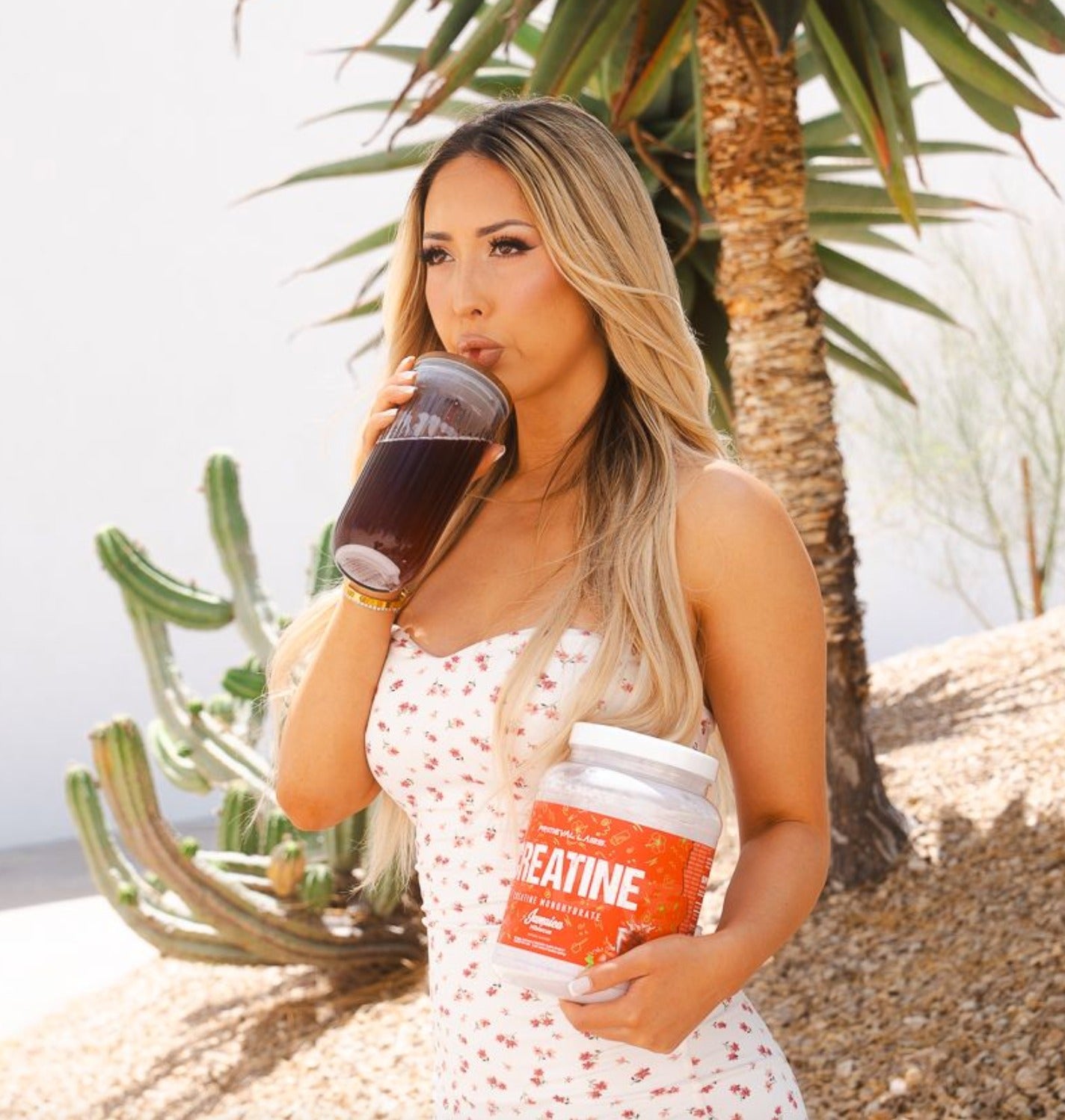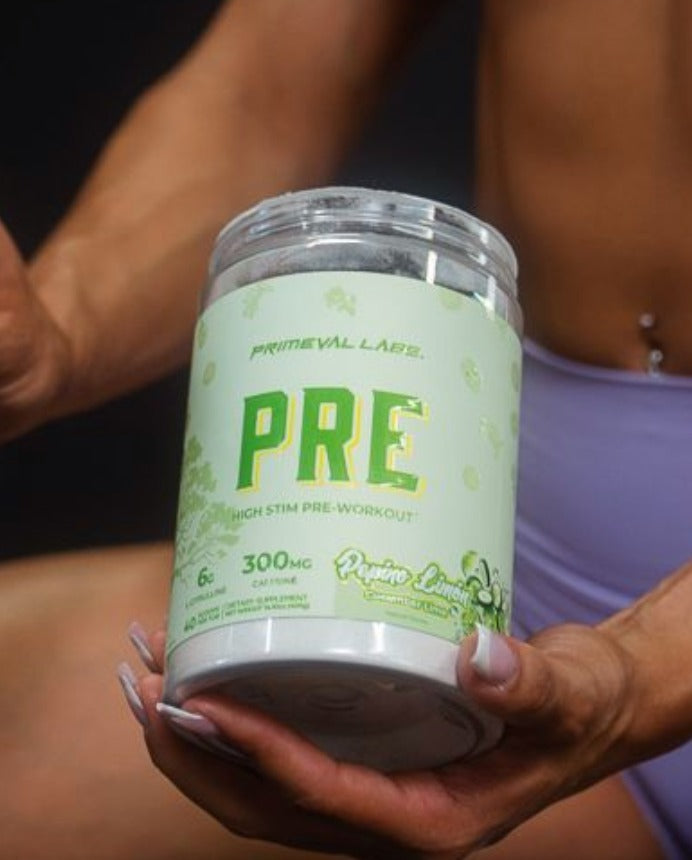Building muscle is a relatively straightforward process. To build muscle, all you need to do is:
-
Consume a sufficient amount of protein
-
Eat a small surplus of calories
-
Lift heavy weights a few times a week
But, if you were like most people when you started training regularly, you invested a mini-fortune on all kinds of supplements, especially ones touted as “muscle builders”, under the guise that they were the secret to making gains.
Unfortunately, you were told a big sack of lies.
Diet, training and sleep have a far greater impact on your ability to build muscle as quickly as possible than any supplement claiming to be a “natural muscle builder” ever could hope.
Now, don’t get us wrong, supplements can (and do) work for improving performance, recovery, and muscle growth. It’s just that the vast majority of the products advertised as “muscle builders” do absolutely jack squat.
Ahead, we’re going to tell you the top 3 best supplements to help build muscle.
Let’s get right to it!
Support Performance & Growth with Prim-ATP!
Prim-ATP is a clinically dosed pre workout supplement combining creatine anhydrous and elevATP.

Top 3 Best Supplements to Build Muscle
Creatine
No surprise here.
If there is one and only one supplement you could buy to help build more muscle as fast as possible, it’s creatine. Period. End of story.
Simply put, creatine is the most well-researched molecule in all of sports nutrition with hundreds upon hundreds of studies documenting its safety and efficacy[37] across a wide range of populations (including children and the elderly).
Various studies have clearly shown that creatine supplements help:
-
Build muscle faster[33]
-
Enhance strength[34]
-
Improve anaerobic exercise performance[35]
-
Boost muscle recovery[36]
So, what is creatine and what does it do exactly?
Well, creatine is a chemical produced in the body and found in foods such as red meat, fish, and eggs. It is composed of the amino acids L-arginine, glycine, and L-methionine, and can be found in just about every cell of your body, where it acts as an energy “backup” of sorts.[38,39]
Supplementing with creatine increases the amount of creatine stored in your muscles.[40]
This, in turn, increases the amount of readily available energy in your muscle cells, and as you would expect, with greater energy, comes greater performance, endurance, strength, and power.
Essentially, creatine helps you lift more weight for more reps with greater recovery. This culminates in better workouts, bigger gains, and more muscle growth.
But, that’s not all.
Creatine also acts as an osmolyte, meaning it increases the amount of water your muscles store.[41] This cell-saturating effect helps improve hydration, stamina, and muscle fullness as well as influencing several factors that impact hypertrophy, including gene expression and nitrogen balance.[42]
Some other research also indicates creatine may exert anti-catabolic effects in the body.[43]
As you know muscle growth comes down to increasing protein synthesis and limiting protein breakdown. So, anything that boots the amount of protein built, or reduces the amount of protein broken down helps build muscle.
With creatine, you get the best of both worlds along with greater performance. Due to the myriad of benefits creatine offers, we’ve included the full 5 gram serving of creatine in every serving of Prim-ATP.
Whey Protein
Chances are when you started training regularly, you were told that protein powder was essential to building muscle.
Well, we hate to break it to you, but protein powder is NOT essential for muscle growth -- consuming enough protein each day is though, and you can get all the protein needed to build muscle from whole food.
But, getting all of your protein from whole food sources (beef, chicken, pork) isn’t always easy, especially if you’re someone who suffers from a poor or low appetite or limited on time.
In these cases, protein powder can be a godsend, as it provides a quick, easy, and delicious way to ensure you get in enough protein each and every day, no matter how short on time you are or how bad of a cook you may be.
Protein powder is also extremely affordable when you factor its price per gram of protein. It’s also low in carbs and fats, which means it can be worked into any meal plan (this becomes increasingly more important when dieting and trying to lose stubborn belly fat).
Thus, it comes as no surprise that people who like to work out regularly use protein powder daily.
Now, there are a lot of options from which to choose when trying to find the “best” protein powder, but the one we’re partial to, hear at Primeval Labs, is whey protein isolate.
We’ve expounded on why whey protein isolate is superior before, but to briefly recap:
Whey protein isolate contains a minimum 90% protein by mass,[44] which is considerably more than whey concentrate given the fact that whey protein concentrate isn’t standardized. In fact, it can vary anywhere from 35-80% protein by mass.
And to make matter worse, supplement companies and manufacturers aren’t required to list which grade of whey concentrate they include in the protein powder.
By choosing a whey isolate protein, such as Primeval Labs ISOLIT, you’re guaranteed to get a high amount of protein in each serving, without wasting a bunch of unnecessary calories on carbohydrates, lactose or milk fat.
Another reason to consider whey protein isolate as your go-to protein powder is that it is rapid digesting, easy on the stomach, and high in leucine -- the “anabolic” trigger that ignites protein synthesis.
While there may be nothing “magical” about protein powder, it is cost-effective, high in protein, easy to prepare/clean, and requires no refrigeration. And, if you choose ISOLIT as your protein powder of choice, you’re guaranteed to have the best tasting whey protein powder on the market, bar none.
Phosphatidic Acid
By now, you know that leucine is important not only for its anti-catabolic properties, but also its ability to stimulate mTOR and drive muscle protein synthesis. Supplementing with EAAs and whey protein provides two ways to get enough leucine to activate mTOR.
But, leucine isn’t the only thing that stimulates mTOR. Yes, isoleucine can stimulate it somewhat, but, there’s yet another way to activate the muscle-building pathways of the body -- phosphatidic acid.
What is Phosphatidic Acid?
One of the newer compounds on the market, phosphatidic acid is an all-natural phospholipid produced in your body during high-intensity exercise, especially eccentric training.
What is a phospholipid?
A phospholipid is a compound comprised of a molecule of glycerol bonded to two fatty acids and a single phosphate group. Phospholipids function as important signaling messengers inside of the cell. And, they also help make up cell membranes.
In fact, the membranes of your muscle cells as well as the organelles inside those cells (i.e. ribosome, mitochondria, etc.) contain phospholipids.
What does any of this have to do with building muscle?
Well, when you lift heavy weights, muscle fibers become damaged. In response to this damage, an enzyme known as phospholipase D generates phosphatidic acid, which signals to your muscles that it’s time to “batten down the hatches”, fortify, and grow.
When phospholipase D is released, it is broken down into phosphatidylcholine (another vital component of cells) into choline and phosphatidic acid.
Researchers who devote their careers to studying cellular biology and physiology discovered that phosphatidic acid leads to muscle growth by directly activating mTOR![45,46,47,48,49,50,51,52]
In other words, phosphatidic acid is to fatty acids (lipids) what leucine is to protein -- an anabolic trigger that sparks protein synthesis and muscle growth.
Upon discovering this sports scientists set out to determine if supplementing with phosphatidic acid could stimulate mTOR, and indeed it does!
In fact, several clinical trials conducted in resistance-trained humans has demonstrated that supplementing with phosphatidic acid leads to significant increases in strength, muscle mass, and recovery.[53,54,55]
There’s also some evidence to suggest that phosphatidic may also help with fat loss and body recomposition, too.
How much phosphatidic acid do you need to take?
Based on the research, an individual needs to supplement with 750mg phosphatidic acid to obtain the benefits outlined in the research.
Now, it’s important to note that not all forms of phosphatidic acid supplements are created equal. In fact, some are just downright awful when it comes to quality.
That’s why we recommend sticking with Mediator Phosphatidic Acid. It’s the only form backed by several clinical trials denoting improvements in lean mass, strength, and body composition.
Mediator phosphatidic acid is derived from soy, which has been found in research to lead to the greatest increases in mTOR signaling.[54]
The Truth About the Best Muscle Building Supplements
Supplements are not repsonsible for building muscle. Even the best muscle building supplements won’t do a lick of good if you’re diet, training, and sleep aren’t in order.
That being said, if you already train consistently (utilizing the principles of progressive overload), consume enough protein, and eat a small surplus of calories, but want to further enhance your results, muscle building supplements can help.
The list of effective supplements (backed by human research) is limited, but there certainly are ones that work and may help you build muscle faster. After you’ve got all your bases covered (diet, training, and sleep), then consider trying any or all of the best muscle building supplements outlined above!
References
-
Removed
-
"MTOR Signaling at a Glance." Journal of Cell Science, 15 Oct. 2009, jcs.biologists.org/content/122/20/3589.
-
Du M , et al. "Leucine Stimulates Mammalian Target of Rapamycin Signaling in C2C12 Myoblasts in Part Through Inhibition of Adenosine Monophosphate-activated Prote... - PubMed - NCBI." National Center for Biotechnology Information, www.ncbi.nlm.nih.gov/pubmed/17178807.
-
Doi M , et al. "Isoleucine, a Potent Plasma Glucose-lowering Amino Acid, Stimulates Glucose Uptake in C2C12 Myotubes. - PubMed - NCBI." National Center for Biotechnology Information, www.ncbi.nlm.nih.gov/pubmed/14651987.
-
Staten MA , et al. "Regulation of Valine Metabolism in Man: a Stable Isotope Study. - PubMed - NCBI." National Center for Biotechnology Information, www.ncbi.nlm.nih.gov/pubmed/6439027.
-
Gomez-Merino D , et al. "Evidence That the Branched-chain Amino Acid L-valine Prevents Exercise-induced Release of 5-HT in Rat Hippocampus. - PubMed - NCBI." National Center for Biotechnology Information, www.ncbi.nlm.nih.gov/pubmed/11510866.
-
Meeusen R and Watson P. "Amino Acids and the Brain: Do They Play a Role in "central Fatigue"? - PubMed - NCBI." National Center for Biotechnology Information, www.ncbi.nlm.nih.gov/pubmed/18577773.
-
Howatson G , et al. "Exercise-induced Muscle Damage is Reduced in Resistance-trained Males by Branched Chain Amino Acids: a Randomized, Double-blind, Placebo Controlled... - PubMed - NCBI." National Center for Biotechnology Information, www.ncbi.nlm.nih.gov/pubmed/22569039.
-
Blomstrand E , et al. "Branched-chain Amino Acids Activate Key Enzymes in Protein Synthesis After Physical Exercise. - PubMed - NCBI." National Center for Biotechnology Information, www.ncbi.nlm.nih.gov/pubmed/16365096.
-
PC, Calder. "Branched-chain Amino Acids and Immunity. - PubMed - NCBI." National Center for Biotechnology Information, www.ncbi.nlm.nih.gov/pubmed/16365100.
-
Hulmi JJ , et al. "Effect of Protein/essential Amino Acids and Resistance Training on Skeletal Muscle Hypertrophy: A Case for Whey Protein. - PubMed - NCBI." National Center for Biotechnology Information, www.ncbi.nlm.nih.gov/pubmed/20565767.
-
Jackman SR , et al. "Branched-Chain Amino Acid Ingestion Stimulates Muscle Myofibrillar Protein Synthesis Following Resistance Exercise in Humans. - PubMed - NCBI." National Center for Biotechnology Information, www.ncbi.nlm.nih.gov/pubmed/28638350.
-
Witard OC , et al. "Myofibrillar Muscle Protein Synthesis Rates Subsequent to a Meal in Response to Increasing Doses of Whey Protein at Rest and After Resistance Exerc... - PubMed - NCBI." National Center for Biotechnology Information, www.ncbi.nlm.nih.gov/pubmed/24257722.
-
Wilkinson DJ , et al. "Effects of Leucine and Its Metabolite β-hydroxy-β-methylbutyrate on Human Skeletal Muscle Protein Metabolism. - PubMed - NCBI." National Center for Biotechnology Information, www.ncbi.nlm.nih.gov/pubmed/23551944.
-
Chow LS , et al. "Mechanism of Insulin's Anabolic Effect on Muscle: Measurements of Muscle Protein Synthesis and Breakdown Using Aminoacyl-tRNA and Other Surrogate M... - PubMed - NCBI." National Center for Biotechnology Information, www.ncbi.nlm.nih.gov/pubmed/16705065.
-
"Effect of Fed- Versus Fasted State Resistance Training During Ramadan on Body Composition and Selected Metabolic Parameters in Bodybuilders." PubMed Central (PMC), www.ncbi.nlm.nih.gov/pmc/articles/PMC3639860/.
-
"The Data Do Not Seem to Support a Benefit to BCAA Supplementation During Periods of Caloric Restriction." PubMed Central (PMC), www.ncbi.nlm.nih.gov/pmc/articles/PMC4865017/.
-
"The Effects of 12 weeks of Beta-hydroxy-beta-methylbutyrate Free Acid Supplementation on Muscle Mass, Strength, and Power in Resistance-trained Individuals: a Randomized, Double-blind, Placebo-controlled Study." PubMed Central (PMC), www.ncbi.nlm.nih.gov/pmc/articles/PMC4019830/.
-
Wilson JM , et al. "β-Hydroxy-β-methylbutyrate Free Acid Reduces Markers of Exercise-induced Muscle Damage and Improves Recovery in Resistance-trained Men. - PubMed - NCBI." National Center for Biotechnology Information, www.ncbi.nlm.nih.gov/pubmed/23286834.
-
Wilkinson DJ , et al. "Effects of Leucine and Its Metabolite β-hydroxy-β-methylbutyrate on Human Skeletal Muscle Protein Metabolism. - PubMed - NCBI." National Center for Biotechnology Information, www.ncbi.nlm.nih.gov/pubmed/23551944.
-
Thomson JS , et al. "Effects of Nine Weeks of Beta-hydroxy-beta- Methylbutyrate Supplementation on Strength and Body Composition in Resistance Trained Men. - PubMed - NCBI." National Center for Biotechnology Information, www.ncbi.nlm.nih.gov/pubmed/19387396.
-
Slater G , et al. "Beta-hydroxy-beta-methylbutyrate (HMB) Supplementation Does Not Affect Changes in Strength or Body Composition During Resistance Training in Traine... - PubMed - NCBI." National Center for Biotechnology Information, www.ncbi.nlm.nih.gov/pubmed/11599506.
-
Kreider RB , et al. "Effects of Calcium Beta-hydroxy-beta-methylbutyrate (HMB) Supplementation During Resistance-training on Markers of Catabolism, Body Composition And... - PubMed - NCBI." National Center for Biotechnology Information, www.ncbi.nlm.nih.gov/pubmed/10606212.
-
Sanchez-Martinez J , et al. "Effects of Beta-hydroxy-beta-methylbutyrate Supplementation on Strength and Body Composition in Trained and Competitive Athletes: A Meta-analysis O... - PubMed - NCBI." National Center for Biotechnology Information, www.ncbi.nlm.nih.gov/pubmed/29249685.
-
Jakubowski JS , et al. "Equivalent Hypertrophy and Strength Gains in HMB- or Leucine-supplemented Men. - PubMed - NCBI." National Center for Biotechnology Information, www.ncbi.nlm.nih.gov/pubmed/30113522.
-
Teixeira FJ , et al. "Leucine Metabolites Do Not Enhance Training-induced Performance or Muscle Thickness. - PubMed - NCBI." National Center for Biotechnology Information, www.ncbi.nlm.nih.gov/pubmed/30102677.
-
Lin JJ , et al. "A Meta-analysis of Trials Using the Intention to Treat Principle for Glutamine Supplementation in Critically Ill Patients with Burn. - PubMed - NCBI." National Center for Biotechnology Information, www.ncbi.nlm.nih.gov/pubmed/23313017.
-
Candow DG , et al. "Effect of Glutamine Supplementation Combined with Resistance Training in Young Adults. - PubMed - NCBI." National Center for Biotechnology Information, www.ncbi.nlm.nih.gov/pubmed/11822473.
-
Abcouwer SF , et al. "Induction of Glutamine Synthetase Expression After Major Burn Injury is Tissue Specific and Temporally Variable. - PubMed - NCBI." National Center for Biotechnology Information, www.ncbi.nlm.nih.gov/pubmed/9095109.
-
Hammarqvist F , et al. "Growth Hormone Together with Glutamine-containing Total Parenteral Nutrition Maintains Muscle Glutamine Levels and Results in a Less Negative Nitro... - PubMed - NCBI." National Center for Biotechnology Information, www.ncbi.nlm.nih.gov/pubmed/11331450.
-
Candow DG, Chilibeck PD, Burke DG, Davison KS, Smith-Palmer T. Effect of glutamine supplementation combined with resistance training in young adults. Eur J Appl Physiol. 2001;86(2):142-149. doi:10.1007/s00421-001-0523-y
-
JD, Branch. "Effect of Creatine Supplementation on Body Composition and Performance: a Meta-analysis. - PubMed - NCBI." National Center for Biotechnology Information, www.ncbi.nlm.nih.gov/pubmed/12945830.
-
Volek JS , et al. "The Effects of Creatine Supplementation on Muscular Performance and Body Composition Responses to Short-term Resistance Training Overreaching. - PubMed - NCBI." National Center for Biotechnology Information, www.ncbi.nlm.nih.gov/pubmed/14685870.
-
Eckerson JM , et al. "Effect of Creatine Phosphate Supplementation on Anaerobic Working Capacity and Body Weight After Two and Six Days of Loading in Men and Women. - PubMed - NCBI." National Center for Biotechnology Information, www.ncbi.nlm.nih.gov/pubmed/16287344.
-
Bassit RA , et al. "Effect of Short-term Creatine Supplementation on Markers of Skeletal Muscle Damage After Strenuous Contractile Activity. - PubMed - NCBI." National Center for Biotechnology Information, www.ncbi.nlm.nih.gov/pubmed/19956970.
-
Groeneveld GJ , et al. "Few Adverse Effects of Long-term Creatine Supplementation in a Placebo-controlled Trial. - PubMed - NCBI." National Center for Biotechnology Information, www.ncbi.nlm.nih.gov/pubmed/15795816.
-
Darrabie MD , et al. "AMPK and Substrate Availability Regulate Creatine Transport in Cultured Cardiomyocytes. - PubMed - NCBI." National Center for Biotechnology Information, www.ncbi.nlm.nih.gov/pubmed/21364119.
-
Guzun R , et al. "Systems Bioenergetics of Creatine Kinase Networks: Physiological Roles of Creatine and Phosphocreatine in Regulation of Cardiac Cell Function. - PubMed - NCBI." National Center for Biotechnology Information, www.ncbi.nlm.nih.gov/pubmed/21390528.
-
McCall W and Persky AM. "Pharmacokinetics of Creatine. - PubMed - NCBI." National Center for Biotechnology Information, www.ncbi.nlm.nih.gov/pubmed/18652081.
-
Safdar A , et al. "Global and Targeted Gene Expression and Protein Content in Skeletal Muscle of Young Men Following Short-term Creatine Monohydrate Supplementation. - PubMed - NCBI." National Center for Biotechnology Information, www.ncbi.nlm.nih.gov/pubmed/17957000.
-
Parise G , et al. "Effects of Acute Creatine Monohydrate Supplementation on Leucine Kinetics and Mixed-muscle Protein Synthesis. - PubMed - NCBI." National Center for Biotechnology Information, www.ncbi.nlm.nih.gov/pubmed/11509496.
-
Tang FC , et al. "Contribution of Creatine to Protein Homeostasis in Athletes After Endurance and Sprint Running. - PubMed - NCBI." National Center for Biotechnology Information, www.ncbi.nlm.nih.gov/pubmed/23392621.
-
Hornberger, T. A., Sukhija, K. B., & Chien, S. (2006). Regulation of mTOR by mechanically induced signaling events in skeletal muscle. Cell Cycle (Georgetown, Tex.), 5(13), 1391–1396. https://doi.org/10.4161/cc.5.13.2921
-
Hornberger TA, Chu WK, Mak YW, Hsiung JW, Huang SA, Chien S. The role of phospholipase D and phosphatidic acid in the mechanical activation of mTOR signaling in skeletal muscle. Proceedings of the National Academy of Sciences of the United States of America. 2006;103(12):4741-4746. doi:10.1073/pnas.0600678103.
-
You JS, Frey JW, Hornberger TA. Mechanical Stimulation Induces mTOR Signaling via an ERK-Independent Mechanism: Implications for a Direct Activation of mTOR by Phosphatidic Acid. Berdeaux R, ed. PLoS ONE. 2012;7(10):e47258. doi:10.1371/journal.pone.0047258.
-
Foster DA. Phosphatidic Acid and Lipid Sensing by mTOR. Trends in endocrinology and metabolism: TEM. 2013;24(6):272-278. doi:10.1016/j.tem.2013.02.003.
-
O’Neil TK, Duffy LR, Frey JW, Hornberger TA. The role of phosphoinositide 3-kinase and phosphatidic acid in the regulation of mammalian target of rapamycin following eccentric contractions. The Journal of Physiology. 2009;587(Pt 14):3691-3701. doi:10.1113/jphysiol.2009.173609.
-
Goodman CA, Mabrey DM, Frey JW, et al. Novel insights into the regulation of skeletal muscle protein synthesis as revealed by a new nonradioactive in vivo technique. The FASEB Journal. 2011;25(3):1028-1039. doi:10.1096/fj.10-168799.
-
Goodman CA, Mayhew DL, Hornberger TA. Recent Progress towards Understanding the Molecular Mechanisms that Regulate Skeletal Muscle Mass. Cellular signalling. 2011;23(12):1896-1906. doi:10.1016/j.cellsig.2011.07.013.
-
Goodman CA, Frey JW, Mabrey DM, et al. The role of skeletal muscle mTOR in the regulation of mechanical load-induced growth. The Journal of Physiology. 2011;589(Pt 22):5485-5501. doi:10.1113/jphysiol.2011.218255.
-
Hoffman JR, Stout JR, Williams DR, et al. Efficacy of phosphatidic acid ingestion on lean body mass, muscle thickness and strength gains in resistance-trained men. Journal of the International Society of Sports Nutrition. 2012;9:47. doi:10.1186/1550-2783-9-47.
-
Joy JM, Lowery RP, Dudeck JE, De-Souza EO, Jager R, McCleary SA, Wilson SMC, Purpura M, Wilson JM. Phosphatidic Acid Supplementation Increases Skeletal Muscle Hypertrophy and Strength. Poster presentation at the ISSN Conference 2013.
-
Bond, P. (2017). Phosphatidic acid : biosynthesis , pharmacokinetics , mechanisms of action and effect on strength and body composition in resistance-trained individuals, 1–9. https://doi.org/10.1186/s12986-017-0166-6











Leave a comment
This site is protected by hCaptcha and the hCaptcha Privacy Policy and Terms of Service apply.